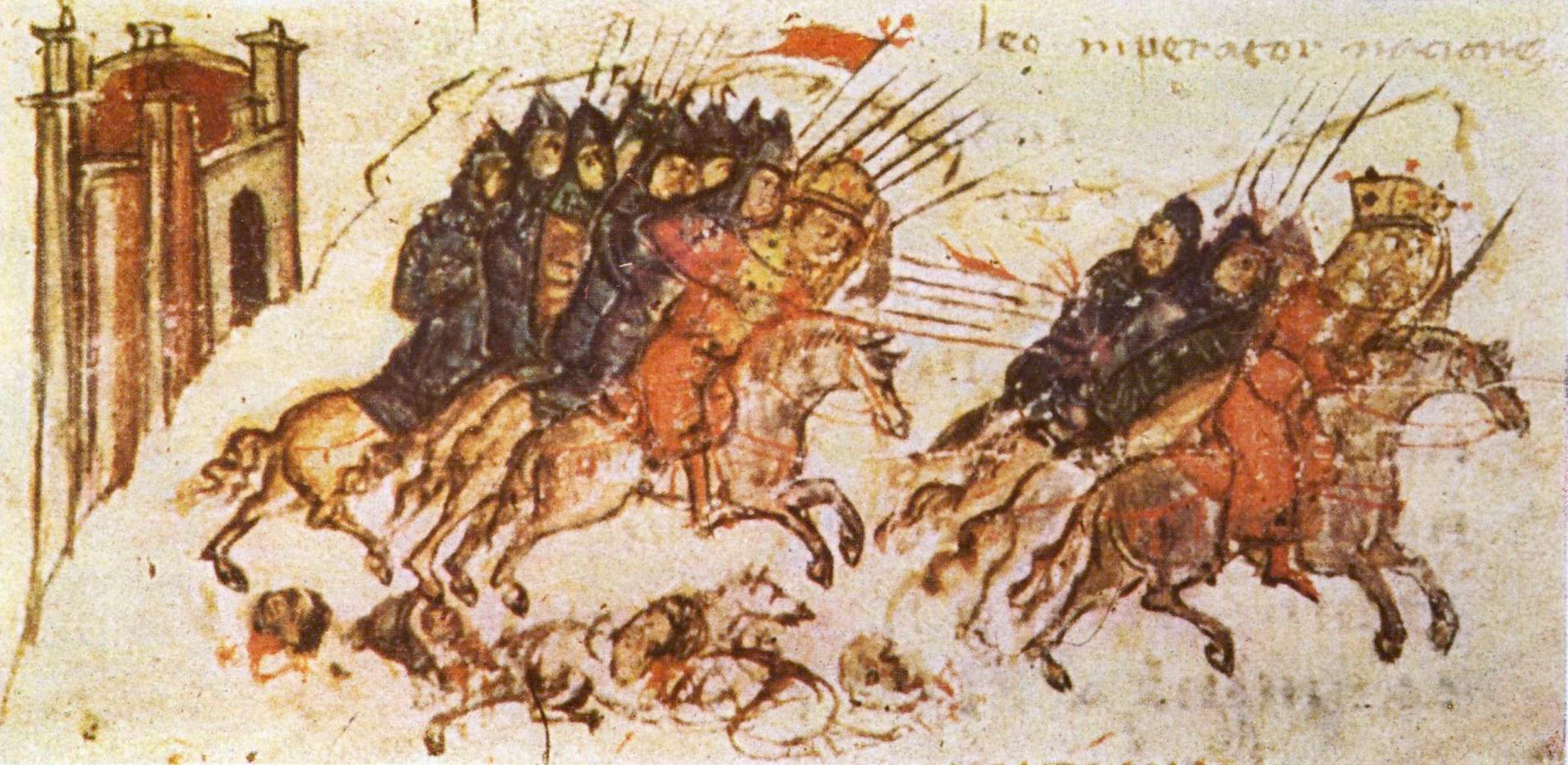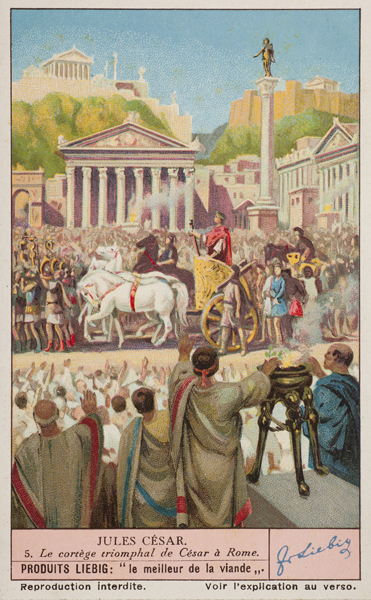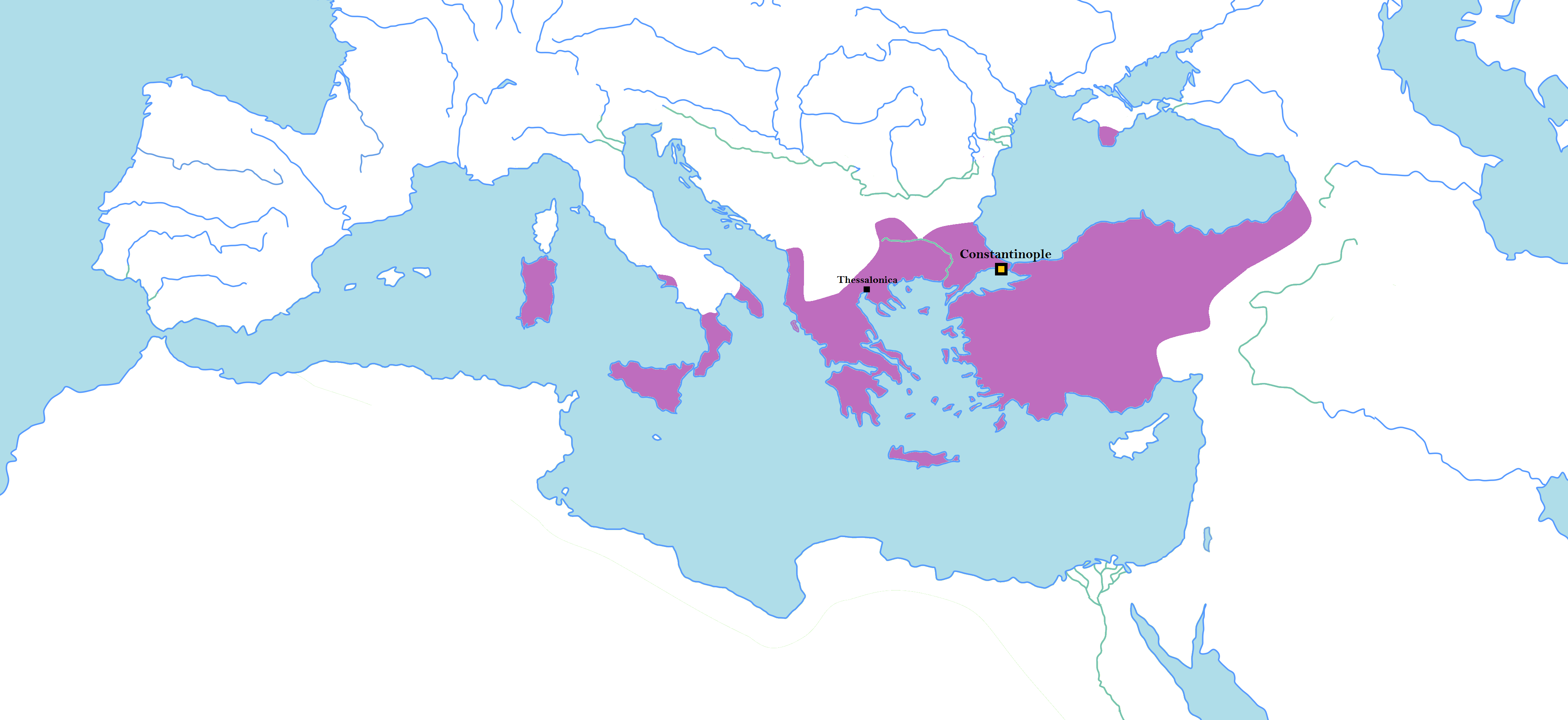|
Battle Of Versinikia
Bulgarian Battle of Versinikia (; ) was a battle fought in 813 AD between the Byzantine Empire and the Bulgarian Empire, near the city of Adrianople (Edirne), in modern-day Turkey. The Bulgarian army, led by Krum of Bulgaria, defeated the Byzantine forces. Following this defeat, Michael I Rangabe abdicated, with Leo V the Armenian taking the Byzantine throne. The battle further strengthened Bulgarian control in the region after their victory over Nikephoros I two years earlier. After the battle, the Bulgarians controlled the whole region of Eastern Thrace (until the Byzantine–Bulgarian Treaty of 815), with the exception of a few castles that remained in Byzantine control. Krum died on 13 April 814, but his muster of "5,000 iron-plated wagons . . . to carry the siege equipment." alarmed the Byzantine court to such an effect that they asked for the aid of the Carolingian Emperor Louis the Pious. These large-scale military preparations were Krum's attempt to avenge his failure ... [...More Info...] [...Related Items...] OR: [Wikipedia] [Google] [Baidu] |
Byzantine–Bulgarian Wars
The Byzantine–Bulgarian wars were a series of conflicts fought between the Byzantine Empire and Bulgaria which began after the Bulgars conquered parts of the Balkan peninsula after 680 AD. The Byzantine and First Bulgarian Empire continued to clash over the next century with variable success, until the Bulgarians, led by Krum of Bulgaria, Krum, inflicted a series of crushing defeats on the Byzantines. After Krum died in 814, his son Omurtag negotiated a thirty-year peace treaty. Simeon I of Bulgaria, Simeon I had multiple successful campaigns against the Byzantines during his rule from 893 to 927. His son Peter I of Bulgaria, Peter I negotiated another long-lasting peace treaty. His rule was followed by a period of decline of the Bulgarian state. In 971 John I Tzimiskes, the Byzantine emperor, subjugated much of the weakening Bulgarian Empire by defeating Boris II of Bulgaria, Boris II and capturing Preslav, the Bulgarian capital. Samuel of Bulgaria, Samuel managed to stabiliz ... [...More Info...] [...Related Items...] OR: [Wikipedia] [Google] [Baidu] |
Bulgars
The Bulgars (also Bulghars, Bulgari, Bolgars, Bolghars, Bolgari, Proto-Bulgarians) were Turkic peoples, Turkic Nomad, semi-nomadic warrior tribes that flourished in the Pontic–Caspian steppe and the Volga region between the 5th and 7th centuries. They became known as Eurasian nomads, nomadic equestrians in the Volga-Ural region, but some researchers trace Bulgar ethnic roots to Central Asia. During their westward migration across the Eurasian Steppe, the Bulgar tribes absorbed other tribal groups and cultural influences in a process of ethnogenesis, including Iranian peoples, Iranic, Finno-Ugric peoples, Finno-Ugric, and Huns, Hunnic tribes. The Bulgars spoke a Turkic languages, Turkic language, the Bulgar language of the Oghur languages, Oghuric branch. They preserved the military titles, organization, and customs of Eurasian steppes as well as pagan shamanism and belief in the sky deity Tengri, Tangra. The Bulgars became semi-sedentary during the 7th century in the Pontic- ... [...More Info...] [...Related Items...] OR: [Wikipedia] [Google] [Baidu] |
Autumn
Autumn, also known as fall (especially in US & Canada), is one of the four temperate seasons on Earth. Outside the tropics, autumn marks the transition from summer to winter, in September (Northern Hemisphere) or March ( Southern Hemisphere). Autumn is the season when the duration of daylight becomes noticeably shorter and the temperature cools considerably. Day length decreases and night length increases as the season progresses until the winter solstice in December (Northern Hemisphere) and June (Southern Hemisphere). One of its main features in temperate climates is the striking change in colour of the leaves of deciduous trees as they prepare to shed. Date definitions Some cultures regard the autumnal equinox as "mid-autumn", while others with a longer temperature lag treat the equinox as the start of autumn. In the English-speaking world of high latitude countries, autumn traditionally began with Lammas Day and ended around Hallowe'en, the approximate mid-poin ... [...More Info...] [...Related Items...] OR: [Wikipedia] [Google] [Baidu] |
Staurakios
Staurakios or Stauracius (; early 790s – 11 January 812) was the shortest-reigning Byzantine emperor, ruling for 68 days between 26 July and 2 October 811. He was born in the early 790s, probably between 791 and 793, to Nikephoros I and an unknown woman. Nikephoros seized the throne of the Byzantine Empire from Empress Irene of Athens, Irene in 802, and elevated Staurakios to co-emperor on 25 December 803. On 20 December 807, a Bride-show, bride show was held by Nikephoros to select a wife for Staurakios, which resulted in his marriage to Theophano of Athens, a kinswoman of Irene. Little else is known of him until he came to take the throne upon the death of Nikephoros. Staurakios took part in an invasion of the Bulgarian Khanate in 811, alongside his father and brother-in-law. Although initially successful, with the Byzantines laying siege to the Bulgarian capital of Pliska and defeating a relief force, they were soon ambushed by Khan Krum, and trapped in a small valley. T ... [...More Info...] [...Related Items...] OR: [Wikipedia] [Google] [Baidu] |
Tyrian Purple
Tyrian purple ( ''porphúra''; ), also known as royal purple, imperial purple, or imperial dye, is a reddish-purple natural dye. The name Tyrian refers to Tyre, Lebanon, once Phoenicia. It is secreted by several species of predatory sea snails in the family Muricidae, rock snails originally known by the name Murex ('' Bolinus brandaris'', '' Hexaplex trunculus'' and '' Stramonita haemastoma''). In ancient times, extracting this dye involved tens of thousands of snails and substantial labour, and as a result, the dye was highly valued. The coloured compound is 6,6'-dibromoindigo. History Biological pigments were often difficult to acquire, and the details of their production were kept secret by the manufacturers. Tyrian purple is a pigment made from the mucus of several species of murex snail. Production of Tyrian purple for use as a fabric dye began as early as 1200 BC by the Phoenicians, and was continued by the Greeks and Byzantine Empire, Romans until 1453 AD, with ... [...More Info...] [...Related Items...] OR: [Wikipedia] [Google] [Baidu] |
Heir
Inheritance is the practice of receiving private property, titles, debts, entitlements, privileges, rights, and obligations upon the death of an individual. The rules of inheritance differ among societies and have changed over time. Officially bequeathing private property and/or debts can be performed by a testator via will, as attested by a notary or by other lawful means. Terminology In law, an "heir" ( heiress) is a person who is entitled to receive a share of property from a decedent (a person who died), subject to the rules of inheritance in the jurisdiction where the decedent was a citizen, or where the decedent died or owned property at the time of death. The inheritance may be either under the terms of a will or by intestate laws if the deceased had no will. However, the will must comply with the laws of the jurisdiction at the time it was created or it will be declared invalid (for example, some states do not recognise handwritten wills as valid, or only in ... [...More Info...] [...Related Items...] OR: [Wikipedia] [Google] [Baidu] |
Battle Of Pliska
The Battle of Pliska or Battle of Vărbitsa Pass was a series of battles between troops, gathered from all parts of the Byzantine Empire, led by the Emperor Nicephorus I, and the First Bulgarian Empire, governed by Khan Krum. The Byzantines plundered and burned the Bulgar capital Pliska which gave time for the Bulgarians to block passes in the Balkan Mountains that served as exits out of Bulgaria. The final battle took place on 26 July 811, in some of the passes in the eastern part of the Balkans, most probably the Vărbitsa Pass. There, the Bulgarians used the tactics of ambush and surprise night attacks to effectively trap and immobilize the Byzantine army, thus annihilating almost the whole army, including the Emperor. After the battle, Krum encased the skull of Nicephorus in silver, and used it as a cup for drinking. This is one of the most documented instances of the custom of the skull cup. The Battle of Pliska was one of the worst defeats in Byzantine history. It det ... [...More Info...] [...Related Items...] OR: [Wikipedia] [Google] [Baidu] |
Nicephorus I
Nikephoros I (; 750 – 26 July 811), also known as Nicephorus I, was Byzantine emperor from 802 to 811. He was General Logothete (finance minister) under Empress Irene, but later overthrew her to seize the throne for himself. Prior to becoming emperor, he was sometimes referred to as "the Logothete" () and "Genikos" or "Genicus" (), in recognition of his previous role as General Logothete. During his reign, Nikephoros engaged in military campaigns against both the Arabs and the Bulgarians, although the outcomes were varied. While leading an invasion into Bulgaria, he suffered a defeat and was killed at the Battle of Pliska. Background According to several sources outside the Byzantine context, such as Michael the Syrian, al-Tabari, and Mas'udi, there is a tradition that suggests Nikephoros had Ghassanid Arab origins and that he descended from the final Ghassanid ruler Jabala ibn al-Ayham. Al-Tabari assets that he obtained this information from Byzantine sources, althoug ... [...More Info...] [...Related Items...] OR: [Wikipedia] [Google] [Baidu] |
Siege Of Constantinople (813)
The siege of Constantinople in 813 () by Khan Krum () was a failed attempt to take the city during the Bulgarian-Byzantine wars. The siege After the Battle of Versinikia (or Second Battle of Adrianople) on 22 June 813, which was a defeat for the Byzantines, Krum's cavalry pursued them and taking advantage of this defeat, Krum advanced towards the walls of Constantinople. Michael I Rangabe was forced to abdicate and become a monk, becoming the third Byzantine emperor removed by Krum since 811. Krum arrived at the city on 17 July 813, and performed a pagan sacrificial ritual involving animals and people in order to impress and force the defenders to surrender. But it was a failure and when Krum saw that the walls were impregnable, he decided to propose peace to the new Byzantine emperor Leo V the Armenian. Krum proposed a meeting, but the Byzantines had set a trap, and he was wounded by archers but managed to flee. Furious, Krum ravaged the environs of Constantinople on the wa ... [...More Info...] [...Related Items...] OR: [Wikipedia] [Google] [Baidu] |
Louis The Pious
Louis the Pious (; ; ; 16 April 778 – 20 June 840), also called the Fair and the Debonaire, was King of the Franks and Holy Roman Emperor, co-emperor with his father, Charlemagne, from 813. He was also King of Aquitaine from 781. As the only surviving son of Charlemagne and Hildegard (queen), Hildegard, he became the sole ruler of the Franks after his father's death in 814, a position that he held until his death except from November 833 to March 834, when he was deposed. During his reign in Aquitaine, Louis was charged with the defence of the empire's southwestern frontier. He Siege of Barcelona (801), conquered Barcelona from the Emirate of Córdoba in 801 and asserted Frankish authority over Pamplona and the Basques south of the Pyrenees in 812. As emperor, he included his adult sons, Lothair I, Lothair, Pepin I of Aquitaine, Pepin and Louis the German, Louis, in the government and sought to establish a suitable division of the realm among them. The first decade of his reig ... [...More Info...] [...Related Items...] OR: [Wikipedia] [Google] [Baidu] |








